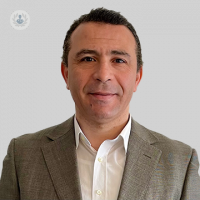Cramp-like pain in the legs? What you should know about peripheral vascular disease
Written by:A cramp-like pain in the legs could be a symptom of peripheral vascular disease, where blocked arteries cause blood-flow problems. If left untreated, the condition may have serious consequences. However, lifestyle changes, exercise and medication can help patients to manage their symptoms and reverse the effects of the disease. In this article, the first of this series on peripheral vascular disease, leading consultant vascular and endovascular surgeon Mr Mohamed Abdelhamid expertly explains the condition’s symptoms and how it is diagnosed and treated.

What is peripheral vascular disease?
Peripheral vascular disease (PVD) is it a term that usually applies to diseases of the blood vessels (arteries) of the lower limbs and sometimes of the upper limbs. It is also referred to as peripheral arterial disease (PAD) and it characterised by a narrowing or blockage of the main blood vessels in the lower limbs. The process is caused by atherosclerosis (hardening of the walls of the arteries) which can cause the arteries to become narrow.
The blood vessels fur up from inside similar to heating pipes and this can make them narrower. This reduces the amount of blood that flows through the arteries going to the legs and as such means that less oxygen is delivered to the leg muscles during exercise. The patient may have a cramp-like pain, ache or heaviness of the leg muscles after walking even short distances and is usually relieved by stopping the exercise.
What are the symptoms?
The symptoms can vary from one person to another and are classified in the following groups:
Asymptomatic: Some patients will not experience any symptoms as they don’t walk enough to trigger the pain in the muscles. This can be due to either the patient being too frail to walk or getting short of breath before they get the pain in the legs. We call these patients asymptomatic (meaning they do not have any symptoms) and as such, it is possible that many people could have blocked arteries without being aware of the fact.
Intermittent claudication: This is the first level of symptoms, characterised by a cramp like pain or ache in a group of muscles like the calf, thigh or buttock that happens with walking or exercise due to a shortage of blood going to this group of muscles and hence low oxygen. This causes a cramp in the muscle that triggers the pain, which disappears when the person stops walking or exercising. The distance that the patient can walk before the symptoms come on is called the claudication distance. According to this distance, we can determine the severity of the narrowing or blockage in the arteries. This also depends on which group of muscles is involved in order to tell us where the blockage in the arteries is.
Critical limb ischaemia: This is the most severe level of symptoms and has recently been named chronic limb threatening ischaemia (CLTI). This represents a severe stage of peripheral arterial disease when there is nerve ischaemia, meaning a significant and critical shortage of blood supply. The patient may present with the presence of ischaemic rest pain (pain in the feet at night that stops the patient from sleeping or causes them to wake), presence of tissue loss, ulcers or gangrene of one of the toes.
How is peripheral vascular disease diagnosed?
Patients with peripheral vascular disease likely have a medical history or symptoms that are suggestive of narrowing of the arteries. This may include pain in the calf muscles with walking that is relieved with rest or pain in one or both feet at night that stops them from sleeping or wakes them from sleep. Examinations can demonstrate the degree of peripheral vascular disease and indicate the extent of blocked arteries.
Investigative scans and tests are also used as part of diagnosis, such an Doppler ultrasound that can detect blood flow in the arteries and demonstrate any narrowing or blockage. CT scans involve injecting contrast to accurately demonstrate the blood flow in the arteries of the lower limbs. Measuring the ankle pressure and comparing it to the pressure in the arm (Ankle Brachial Pressure Index, ABPI) can also be used to demonstrate the pressure in the ankle and this can give an idea of the blood flow going through the leg. Measuring of the pressure in the toes is another tool used to check the blood flow in the toes which is especially useful in patients with diabetes and chronic kidney disease.
What treatment options are available? Is it curable or reversible?
The treatment options are variable and available depending on the degree of symptoms and signs of the patient. There are three principal approaches to treatment:
Conservative treatment includes treatment of the risk factors, for example diabetes, high blood pressure and high cholesterol. For smokers, quitting is essential and crucial in improvement of the symptoms and stopping the condition from getting worse. The term best medical therapy (BMT) which includes the use of antiplatelets (aspirin or clopidogrel), statins (cholesterol lowering tablets) and control of the risk factors to improve the condition and avoid deterioration.
Additionally, an exercise programme which encourages the patient to exercise in the form of walking, cycling and swimming amongst other activities to improve the collateral circulation (small blood vessels) which can improve blood flow to the legs.
Active intervention is also available depending on the severity of the condition, the nature of the disease and the blocked arteries. This could be in the form of balloon angioplasty (stretching the blocked artery with a balloon), a stent (placing a metal stent across the narrowed or blocked arteries) or bypass surgery. The intervention can be done either under local anaesthetic as is the case with angioplasty or stent; or it can be under general anaesthetic if the patient requires more complex intervention.
Although serious, it is important to note that peripheral vascular disease can be reversed and cured with a combination of best medical therapy, an exercise programme and active intervention.
If you are concerned about symptoms of peripheral vascular disease or would like more information, you can book a consultation with Mr Abdelhamid by visiting his Top Doctors profile.


